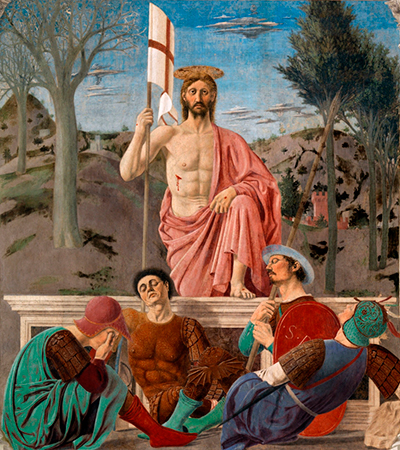The Resurrection from the 1460s is one of Piero della Francesca's most famous paintings and can now be found in the Palazzo della Residenza in Sansepolcro, Tuscany.
This painting was intended for private worship prior to the commencing of meetings in this location and for that reason was a particularly personal commission for the locals of this Italian town. Its importance was matched by the prominent position that it was given once completed by the artist, hanging just above the entrance to the building.
Besides being a great artist within his own day, Piero Della Francesca's art is still considered outstanding even in the present day. Innovation then was nothing compared to what it is today, with accepted forms and styles of art being much more narrow. Below are some of his major artworks from a long and distinguished career.
Polyptych of the Misericordia
The commissioning of this artwork happened in 1445. It took Piero 17 years to paint it slowly and complete it though he still handled other projects. The Polyptych was quite large and could probably be anticipated to serve as the altarpiece. At the polyptych’s center is the Madonna of Mercy (Madonna della Misericordia), which the artwork commissioning confraternity had much dedication. Usage of some limited colors and geometrical shapes refine the polyptych with a somewhat modern "unreality" which easily prompts a solemn contemplation to the viewer. The carvings and tympanum used are quite symbolic.
Baptism of Christ
A classically posed and serene Christ is standing at the middle of this painting. The hands are perfectly curved to a gesture of prayers. John Baptist then pours water onto the head of Christ, thus a baptism. The background landscape is crafted in a way that sends the mind in a solemn mood. Piero's trademark simplified forms, landscapes, and the use of symbolic geometry are all present in this ancient work.
Death of Adam
Piero's well-known geometry was crucial to almost every of his painting composition. In this case, Death of Adam, the tree formed a column located at the picture-perfect center of this painting, which branches out to the clear blue sky. The triangular composition in the collection of his figures and the monochromatic treatment of color gives this painting a perfect sense of pictorial unity. Despite the depiction of three sequential stages in one painting, Piero succeeds in making every scene to remain seamlessly fitting together within a common and continuous landscape. The monochromatic and pale palette of the painting, as accompanied by the geometrical shapes that are from the bodies of art figures, served as an influence to some 20th-century artists, especially Balthus.
The Resurrection
It is one of his paintings that proved his immense creativity. The sculpture shows some four soldiers lying at the entrance of Christ's tomb. However, Christ is on it upon his resurrection. The mixing of colors, shaping and curving show an artist who was keen on giving the best. It is, even more, captivating seen the use of space in making the painting.




